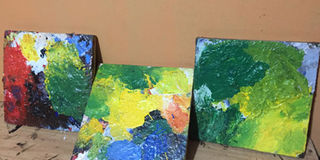Simple beautiful paintings for your house

Final product of artist Sylvia Nkesiga’s work. Photo by Desire Mbabaali
Paintings are some of the artifacts that can light up your home and give it an expensive look. However, beautiful paintings mean parting with hundreds of thousands, and not all of us can afford to. However, there is another alternative to having those beautiful paintings but at a less price. Sylvia Nkesiga an industrial artist, shares how anyone can bring this project to life.
“You do not have to be a perfect artist; creativity is all you need. As long as you have an artistic eye, this will be every simple to execute. Instead of using a canvas, we shall use paper for our project and instead of using other paints like acrylics or oils, we shall use water colour,” she explains adding that water colours works best on paper.
However, not every paper will work, so buy water colour paper from bookshops around you. Cut then according to the size of your frames where you will have your painting framed. Additionally, buy water colours, which are usually in small tubes. You will also need a set of paint brushes with which to paint and if possible, a palette knife with which to mix the paint.
“You have to understand that water colour dries up so fast and so, it will dry as you paint so in case you need to mix and blend colors, do it fast as you paint. But again, use very little water while mixing the water colour. Just add a little water to make it a little fluid on the brush,” Nkesiga narrates.
Getting to work
The safest and easiest way to pull this off for armature painters, Nkesiga advises, is to paint patterns in the same or in different colours of preference instead of pictures unless you trust your art. Using a pencil, softly sketch out your desired patterns onto the paper. This may be a single circle or a number of them, straight lines, rectangles, diagonal lines, as one may want. “Make sure the colours will compliment or fit right into your room’s colours.
Having mixed your colour already, get hold of a brush, (the bigger you want your patterns to be, the bigger the brush you should use, and the reverse is true), touch it in your colour mixture and do a single straight stroke tracing along the sketches. Do not put too much paint on the brush, so make sure colour isn’t dripping, unless you want it to,” she explains.
After finishing your painting, let it completely dry.
On drying, get your frames (of your desired size and colour) and frame the painting. Depending on how many paintings you make, hung these in close proximity with each other to bring out the complete look.
“The reason you need to frame your water colour paintings is that it is not easy to keep outside of a frame for a long time with out getting it stained. But again, frames give it a more beautiful look and can be hanged anywhere in the house.




